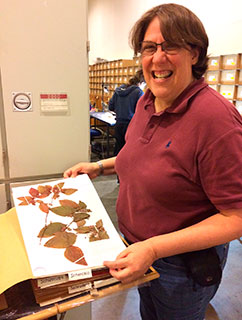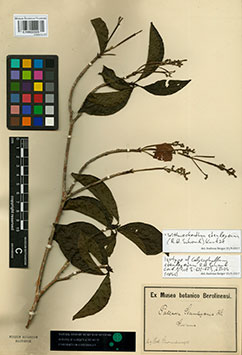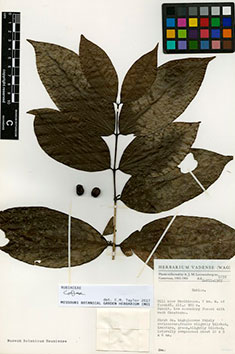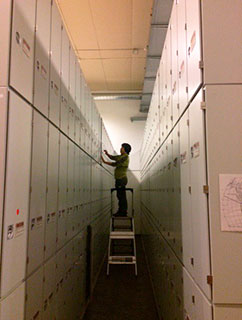Danish museum discovers unique coffee plants in the collections
The Herbarium of the Natural History Museum of Denmark is a treasure chest of more than 2.9 million plant specimens collected over 400 years and from all over the World. Some plants are easy to identify, but many of them require expert knowledge for identification to species, and the unidentified specimens are compiling on the shelves over years and centuries. For this reason, the museum recently invited a group of international experts to join a full day workshop in the Museum’s herbarium, where the Coffee family, the world’s 4th largest plant family with more than 13.000 species was examined. The workshop was an overwhelming success, where over 500 unidentified coffee plants and 19 unique type-specimens were discovered in the museum's collections.

After years of searching in herbaria across South America for the rare Shenkea blumenaviana, Helga Ochoterena from The National Herbarium of Mexico finds a specimen in the collections of the herbarium of the Natural History Museum of Denmark. Even more excitingly, it turned out that this collection originated from the museum's Botanical Gardens in Copenhagen, which in addition to this species includes many rare plants, and thereby constitute an important research collection.
The Museum’s collections include circa 20.000 specimens of the coffee family and during the workshop, the experts named as many as 569 of the 765 unidentified collections. The collections of the coffee family already included also 334 so-called type-specimens, which is the specific specimen on which a name and description of a species is based. During the workshop, the experts discovered another 19 type-specimens, which will now be available for the international research environment.
Curator and professor Nina Rønsted is pleased about the overwhelming results of the workshop. Previously, several cupboards were filled with coffee plants without names, now there are only a few shelves left with unidentified specimens. She sends her gratitude to the international experts, who helped with bringing a little more order in the museums huge collections.
- We are of course taking good care of our collections on a daily basis, but with a huge and old collection as ours, there will always be parts, that have not been given specialist attention for a long time, says curator and professor Nina Rønsted from the Natural History Museum of Denmark and continues:
- The workshop was an opportunity to have a closer look at a part of our unidentified collections, and the result is amazing and include a lot of really exciting discoveries. The value of our collections has increased and new opportunities for future research have been created.

The experts discovered a total of 19 new type-specimens in the collections. One of them is a collection of Wittmackanthus stanleyanus from Guyana, which was sent to the museum's herbarium from the herbarium in Berlin, which burned down during the second World War. The Berlin herbarium was an important historical collection which was totally lost in Berlin, but this type-specimen was luckily secured for the future in our museum in Denmark.
Biodiversity, medicine, and foods
On a daily basis, the plant collection is used as a reference for verification of species identifications of new collections, as well as a basis for improving our understanding of the worlds biodiversity, changes in the distribution patterns of species, and where we can find new medicines or new interesting crops in nature.
With our circa 2.7 million plant specimens, the museums herbarium constitutes one of the world’s largest plant collections, and its size and value impresses the experts. Not least, because of the many important historical collections from early Danish expeditions in for example South America and Africa, and only few herbaria have so many several hundred years old collections.
Facts about the coffee family
The coffee family (Rubiaceae) includes in addition to the coffee genus (Coffea) also quinine bark (Cinchona), which has been the only source of quinine used for the treatment of malaria for more than 300 years, the red colouring madder (Rubia), and a number of popular ornamental plants such as Gardenia. The coffee family is primarily tropical plants, but in Denmark and Europe we find Galium species including cleavers or catchweed, which has hooks enabling them to climb, but also to catch onto our clothes and the dogs fur.
Related News
Contact
Nina Rønsted
Professor
Natural History Museum of Denmark
University of Copenhagen
Mobile: +45 23 81 12 03
E-mail: nronsted@snm.ku.dk
Coffea nkolbissonii

Three collections of the true cofee genus - Coffea - was also discovered among the unidentified specimens. According to Coffea expert Aaron Davis from the Royal Botanic Gardens Kew, one of them is probably a new species, which will be named Coffea nkolbissonii after the area in Cameroon where it was first collected.
Photo
The photos on this site must be used in conjunction with media coverage of the story. Click on the photos to download them in high resolution. Please credit the photographer.

